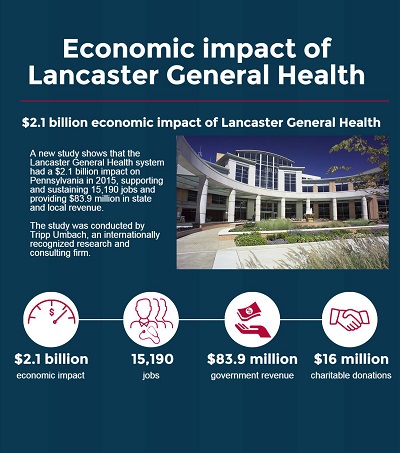 A new study shows that the Lancaster General Health system had a $2.1 billion impact on Pennsylvania in 2015, supporting and sustaining 15,190 jobs and providing $83.9 million in state and local revenue. The study was conducted by Tripp Umbach, an internationally recognized research and consulting firm.
A new study shows that the Lancaster General Health system had a $2.1 billion impact on Pennsylvania in 2015, supporting and sustaining 15,190 jobs and providing $83.9 million in state and local revenue. The study was conducted by Tripp Umbach, an internationally recognized research and consulting firm.
The study included LG Health’s keystone facility, Lancaster General Hospital, its network of more than 300 employed physicians, Lancaster General Health Physicians, and facilities and services associated with its license, which include the Women & Babies Hospital and 14 outpatient centers, including the Downtown and Suburban outpatient pavilions. The study did not include the impact of its Pennsylvania College of Health Sciences, which conducted its own economic impact study in 2012, or any facility or service not wholly owned by the system.
“LG Health is an integral part of the state’s economy, generating revenue, jobs and spending,” said Jan L. Bergen, LG Health president and chief executive officer. “Studies like this capture only the impact that can be assigned a number. But the qualitative value and impact of our system goes far beyond its annual multi-billion-dollar economic impact.”
The study also showed that LG Health employees contribute more than $16 million annually in charitable donations and volunteer service throughout the region.
Total Economic Impact
The total economic impact of $2.1 billion measures the dollars that are generated within Pennsylvania due to the presence of LG Health. This includes not only spending on goods and services with vendors in Pennsylvania and the spending of its staff and employed physicians, but also the business volume generated by businesses within Pennsylvania that benefit from LG Health spending.
The businesses that receive direct payments re-spend this money within the state, thus creating the need for even more jobs. Not all dollars spent by a health system remain in its home state. Dollars that “leak” out of the state in the form of purchases from out‐of‐state vendors are not included in the LG Health’s economic impact estimates.
Impact on Jobs
The health system supports 15,190 jobs in Pennsylvania, both full-time and part-time. They include not only direct employment, but also jobs created by supply and equipment vendors, contractors and laborers for the construction and renovation of facilities and jobs created in the community at hotels, restaurants and retail stores in support of the system’s workforce and its visitors.
The system directly employed 7,278 people during the 2015 fiscal year and supported 7,912 jobs statewide in virtually every sector of the Pennsylvania economy.
Impact on State and Local Governments
“It is a common misperception that non-profit organizations do not generate tax revenue. But that is not at all the case,” said Bergen. “Through our local spending, as well as direct and indirect support of jobs, the presence of the health system stabilizes and strengthens the local and statewide tax base.”
State and local government revenues attributable to the presence of LG Health totaled $83.9 million ($24.4 million in direct taxes) in fiscal year 2015.
Methodology
The economic impact of LG Health/Penn Medicine was estimated using IMPLAN (Impact Analysis for PLANing), an econometric modeling system developed by applied economists at the Hospital of Minnesota and the U.S. Forest Service. The IMPLAN modeling system has been in use since 1979 and is currently used by more than 500 private consulting firms, hospital research centers and government agencies.
The IMPLAN modeling system combines the U.S. Bureau of Economic Analysis’ Input-Output Benchmarks with other data to construct quantitative models of trade flow relationships between businesses and between businesses and final consumers. From this data, the effects of a change in one or several economic activities to predict its effect on a specific state, regional or local can be seen.
The IMPLAN input-output accounts capture all monetary market transactions for consumption in a given time period. The IMPLAN input-output accounts are based on industry survey data collected periodically by the U.S BEA and follow a balanced account format recommended by the United Nations.
Contact:
Lancaster General Health
John Lines, 717-544-5054
jplines@LGHealth.org